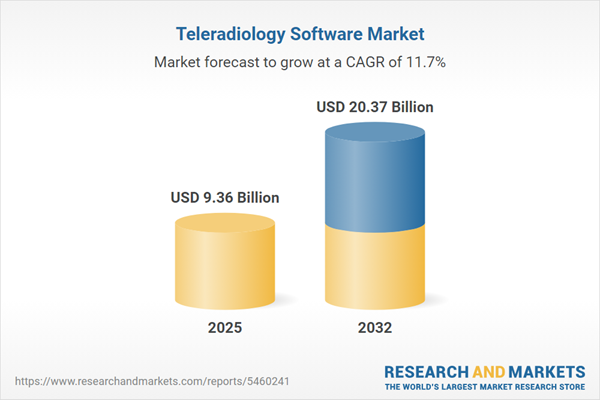Speak directly to the analyst to clarify any post sales queries you may have.
The teleradiology software market is rapidly transforming diagnostic imaging and remote collaboration in healthcare. As radiology services increasingly move to connected, cloud-driven platforms, senior leaders face complex choices regarding technology, compliance, and operational integration.
Market Snapshot: Teleradiology Software Market Growth and Outlook
The Teleradiology Software Market grew from USD 8.38 billion in 2024 to USD 9.36 billion in 2025. It is expected to continue expanding at a CAGR of 11.74%, reaching USD 20.37 billion by 2032. This sustained acceleration reflects the sector’s crucial role in bridging the gap between remote diagnostic sites and centralized expert analysis, fueling operational efficiency, accessibility, and collaboration in global patient care.
Scope & Segmentation
- Component: Services (Managed Services, Professional Services), Software (Clinical Workflow Management, Integrations, Reporting Solutions)
- Modality: CT Scan (Cardiac CT, Neuro CT), MRI, Ultrasound (Abdominal, Cardiac), X-Ray
- Deployment Mode: Cloud, On Premises
- End User: Diagnostic Centers, Hospitals (Private Hospitals, Public Hospitals), Imaging Centers
- Application: Integrations, Reporting (Automated Reporting, Collaborative Reporting), Workflow Management (Scheduling, Task Automation)
- Regional Coverage: Americas (North America: United States, Canada, Mexico; Latin America: Brazil, Argentina, Chile, Colombia, Peru), Europe, Middle East & Africa (Europe: United Kingdom, Germany, France, Russia, Italy, Spain, Netherlands, Sweden, Poland, Switzerland; Middle East: United Arab Emirates, Saudi Arabia, Qatar, Turkey, Israel; Africa: South Africa, Nigeria, Egypt, Kenya), Asia-Pacific (China, India, Japan, Australia, South Korea, Indonesia, Thailand, Malaysia, Singapore, Taiwan)
- Companies Analyzed: GE Healthcare Inc., Koninklijke Philips N.V., Fujifilm Holdings Corporation, Agfa-Gevaert N.V., Intelerad Medical Systems, Inc., TeraRecon, Inc., RamSoft Inc., Infinitt Healthcare Co., Ltd., eRAD Inc., Novarad Corporation
Key Takeaways for Senior Decision-Makers
- AI-driven enhancements and advanced interoperability are actively reshaping diagnostic workflows, allowing clinicians to access and interpret images with greater speed and accuracy.
- The integration of secure, cloud-based deployment models has substantially increased scalability and geographic reach, making expert consultation available across regions and healthcare settings.
- Regulatory emphasis on data security is prompting organizations to embed encryption and continuous monitoring into teleradiology systems, ensuring alignment with global privacy mandates and building trust with patients.
- Market segmentation by end user, modality, and deployment reveals adoption patterns influenced by clinical priorities and local infrastructure, aiding targeted growth strategies.
- Established vendors compete with agile innovators through integrated platforms, AI analytics, and rapid deployment solutions that optimize efficiency in radiology departments.
Tariff Impact on Teleradiology Software Ecosystem
The 2025 United States tariff regime has escalated import costs for hardware components such as imaging workstations and security appliances, leading vendors to reassess supply chains and develop local manufacturing partnerships. For software delivery, increased duties on data transmission and encryption modules are driving firms to set up regional development hubs, supporting product release agility and sustained pricing competitiveness. This has redefined how organizations prioritize their investments, with a marked shift toward cloud-native architectures to decrease dependence on physical imports and lessen regulatory exposure.
Methodology & Data Sources
This report leverages a robust mixed-method research approach, integrating secondary data from industry publications, regulatory filings, and peer-reviewed journals with primary insights captured from interviews with radiology department heads, IT executives, and solution providers. Quantitative surveys of healthcare organizations and imaging centers across global regions support complementary trend validation and comprehensive market structuring.
Teleradiology Software Market: Why This Report Matters
- Delivers actionable intelligence on emerging technology and market trends for C-suite leaders to inform capital allocation and product strategy.
- Identifies regulatory priorities and risks crucial for maintaining compliance and trust as digital healthcare matures.
- Enables benchmarking against established competitors and fast-moving innovators across key regions and applications.
Conclusion
Teleradiology software stands at the forefront of digital transformation in healthcare diagnostics. Strategic focus on advanced technologies, adaptive supply chains, and robust compliance is vital to realizing growth and improved patient outcomes.
Additional Product Information:
- Purchase of this report includes 1 year online access with quarterly updates.
- This report can be updated on request. Please contact our Customer Experience team using the Ask a Question widget on our website.
Table of Contents
3. Executive Summary
4. Market Overview
7. Cumulative Impact of Artificial Intelligence 2025
Companies Mentioned
The companies profiled in this Teleradiology Software market report include:- GE Healthcare Inc.
- Koninklijke Philips N.V.
- Fujifilm Holdings Corporation
- Agfa-Gevaert N.V.
- Intelerad Medical Systems, Inc.
- TeraRecon, Inc.
- RamSoft Inc.
- Infinitt Healthcare Co., Ltd.
- eRAD Inc.
- Novarad Corporation
Table Information
| Report Attribute | Details |
|---|---|
| No. of Pages | 197 |
| Published | October 2025 |
| Forecast Period | 2025 - 2032 |
| Estimated Market Value ( USD | $ 9.36 Billion |
| Forecasted Market Value ( USD | $ 20.37 Billion |
| Compound Annual Growth Rate | 11.7% |
| Regions Covered | Global |
| No. of Companies Mentioned | 11 |









